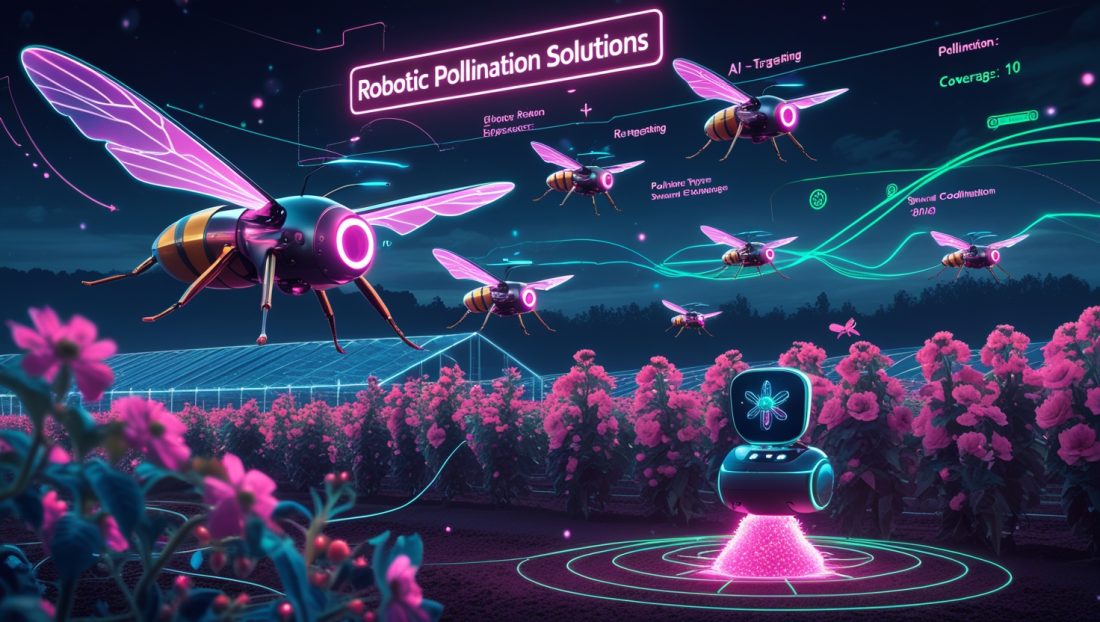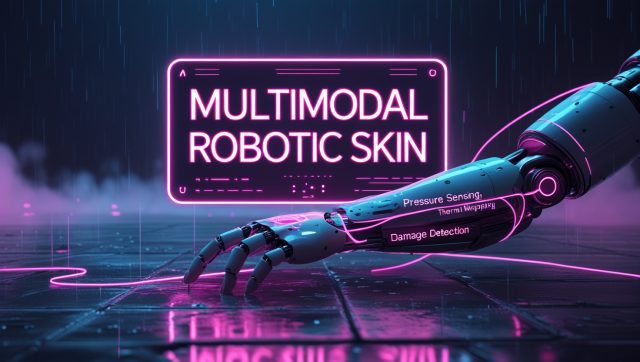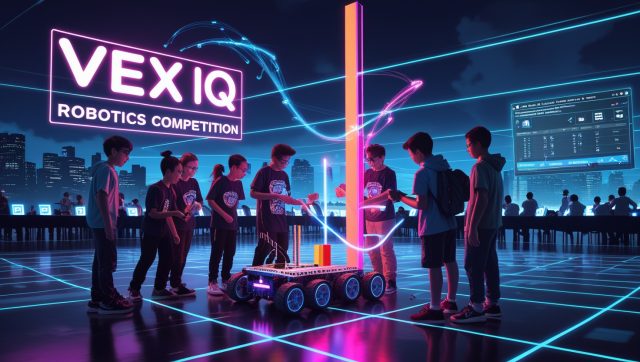A World Without Bees — Can Technology Fill the Void?
Imagine walking into a grocery store where apples, almonds, and blueberries have vanished from the shelves. This dystopian scenario is inching closer to reality as bee populations collapse worldwide. In 2023, U.S. beekeepers reported losing 48% of their honeybee colonies — the second-highest mortality rate on record. For farmers like Maria Gonzalez (a fictional composite), a third-generation almond grower in California’s Central Valley, this crisis is personal. “My family’s livelihood depends on bees,” she says. “But now, we’re lucky to see a handful in our orchards.”
The stakes couldn’t be higher: 75% of global food crops rely on pollinators. Enter robotic pollination solutions — a fusion of artificial intelligence, robotics, and biomimicry designed to replicate nature’s most underrated workforce. But can machines truly mimic 400 million years of evolutionary refinement? And at what cost? To understand the broader implications of such technologies, consider how AI-driven automation is revolutionizing industries like grocery, showcasing the potential for robotics to transform agriculture.
1. The Silent Crisis: Why Robotic Pollination Solutions Are No Longer Optional
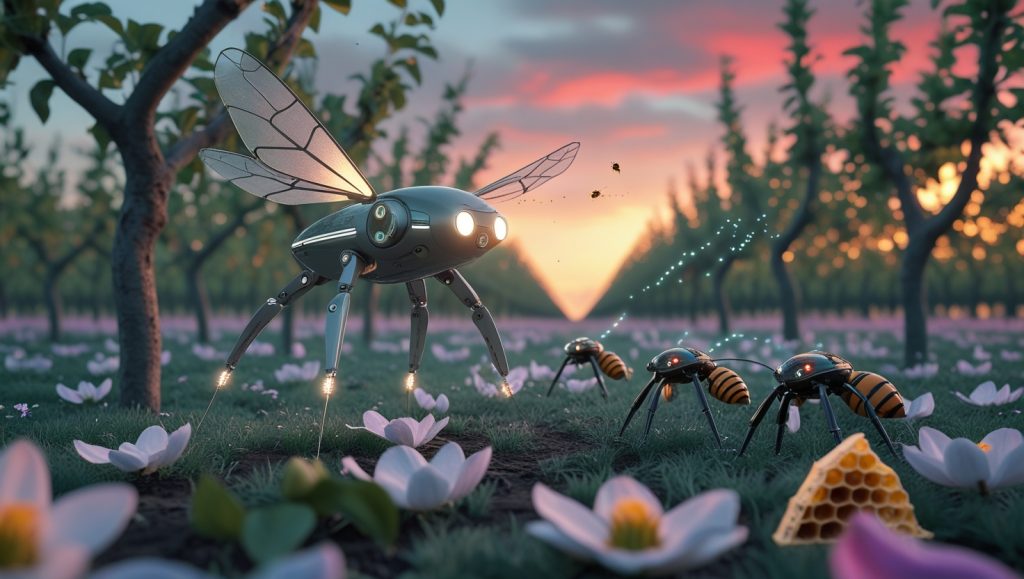
A Collapse in Slow Motion
Pollinators contribute $577 billion annually to the global economy, yet their numbers are plummeting. Since 2006, the U.S. has lost 60% of commercial honeybee colonies, while wild pollinators like bumblebees and butterflies face localized extinction. The causes are multifaceted:
- Pesticides: Neonicotinoids reduce bees’ navigational abilities, effectively leaving them “lost” in the wild.
- Habitat Loss: Urbanization and monoculture farming have eradicated 98% of wildflower meadows in the UK since the 1930s.
- Climate Change: Rising temperatures disrupt synchronicity between plant blooming and pollinator activity.
Dr. Dave Goulson, author of Silent Earth: Averting the Insect Apocalypse, warns:
“We’re dismantling ecosystems piece by piece. If pollinators vanish, our current agricultural system collapses within years.”
Why Robotic Pollination Solutions Are Critical Now
The urgency of robotic pollination solutions cannot be overstated. As natural pollinators dwindle, these technologies offer a lifeline to farmers facing crop failures. Unlike traditional methods, robotic pollination solutions leverage AI and precision engineering to address immediate needs while conservation efforts lag. For instance, similar advancements in robotics for recycling highlight how automation can tackle global crises, underscoring the potential of robotic pollination solutions to stabilize food production.
The Rise of Robotic Pollination Solutions
In response, engineers and agronomists are racing to develop robotic pollination solutions. While critics argue these technologies are a Band-Aid for systemic environmental failures, proponents see them as a critical stopgap. “We’re not trying to replace bees,” says Dr. Eijiro Miyako, a pioneer in robotic pollination at Japan’s National Institute of Advanced Industrial Science and Technology. “We’re buying time to fix the root problems.” This pragmatic approach mirrors innovations like Singapore’s robotics ecosystem, where collaborative tech hubs accelerate solutions for global challenges.
2. Five Robotic Pollination Solutions Transforming Agriculture
A. Drone Pollinators: Bridging the Gap Between Lab Face-to-Face
MIT’s Agile RoboBees — weighing just 0.6 grams — mimic the aerodynamics of real bees, achieving sustained flight through soft artificial muscles. In 2022, these drones successfully pollinated lilies in a controlled greenhouse at Wyss Institute. However, challenges remain:
- Battery Life: Current models last only 17 minutes, versus 8 hours for a honeybee’s daily foraging.
- Precision: Drones struggle with complex flower structures like orchids, which require “buzz pollination” (vibrating to release pollen).
Meanwhile, Dropcopter, a U.S.-based startup, has deployed apple orchard drones in New York since 2021. For a deeper dive into the latest advancements in drone-based robotic pollination solutions, including air-jet and ultrasonic wave technologies, last year’s comprehensive review highlights their potential and limitations in greenhouse settings. Their fixed-wing drones spray pollen from above, boosting yields by 25–50% in trials. Yet CEO Matt Koball admits scaling is tricky: “Bees work for free. Our drones cost $1,000 per acre per season.” For more on drone technology, explore how drone delivery networks are reshaping logistics, offering parallels to robotic pollination solutions.
B. AI-Driven Smart Greenhouses: Precision Meets Automation
Israeli startup Arugga AI Farming has taken a different approach. Their ground-based robot, Polly, uses computer vision to identify tomato flowers and delivers targeted air pulses to mimic bumblebee vibrations. In 2023 trials, Polly achieved 92% pollination success — matching natural bees.
But AI greenhouses aren’t without flaws. “Tomatoes are easy — they self-pollinate with vibration,” says entomologist Dr. Claire Kremen. “For crops like blueberries or almonds, we need solutions that handle delicate, irregular flowers.” The precision of robotic pollination solutions like Polly draws parallels to BMW’s humanoid robot precision manufacturing, where AI enhances efficiency.
C. Swarm Robotics: Nature’s Blueprint for Efficiency
Harvard’s RoboBee Swarm Project aims to deploy thousands of miniature drones that communicate like real bees. In 2024, the team achieved a breakthrough: 102 drones collaborating to map and pollinate a mock orchard. Yet replicating swarm intelligence at scale remains elusive.
“Bees make collective decisions in real time — which flowers to visit, when to abandon a site,” explains Dr. Radhika Nagpal, a Harvard roboticist. “Our algorithms are still rudimentary by comparison.” This swarm approach aligns with humanoid robot swarm intelligence, showcasing how robotic pollination solutions can emulate nature’s complexity.
Why Swarm-Based Robotic Pollination Solutions Are Game-Changers
Swarm-based robotic pollination solutions offer unmatched scalability, mimicking the collective efficiency of bee colonies. By distributing tasks across multiple units, these systems reduce the strain on individual robots, addressing battery and precision limitations. As robotic pollination solutions evolve, swarm technology could redefine agriculture, much like quantum machine learning in robotics is transforming decision-making.
D. 3D-Printed Robotic Flowers: A Bridge Between Biology and Tech
Australian artist Michael Candy’s Synthetic Pollenizer — a 3D-printed flower that dispenses nectar — attracted real bees in 85% of field tests. While still experimental, the project highlights how human ingenuity can complement nature. “The goal isn’t to replace bees,” Candy says, “but to create environments where they can thrive alongside technology.” This hybrid approach resonates with robotics in 3D printing, where robotic pollination solutions blend innovation with sustainability.
E. Smart Beehives: Prevention Over Replacement
Not all solutions focus on replacing bees. ApisProtect, an Irish company, uses IoT sensors to monitor hive health. Their AI predicts diseases like varroa mite infestations with 89% accuracy, allowing beekeepers to intervene early. “Healthy bees are still the best pollinators,” says CEO Fiona Edwards Murphy. This preventive strategy complements robotic pollination solutions and aligns with AI-driven cybersecurity threat detection, emphasizing proactive solutions.
Why Smart Beehives Enhance Robotic Pollination Solutions
Smart beehives amplify the effectiveness of robotic pollination solutions by ensuring healthier bee populations, reducing reliance on robots. By integrating IoT and AI, these systems create a symbiotic relationship between technology and nature, optimizing pollination outcomes. This synergy reflects broader trends in edge AI for real-time intelligence, enhancing the impact of robotic pollination solutions.
3. Challenges: The Limits of Robotic Pollination Solutions
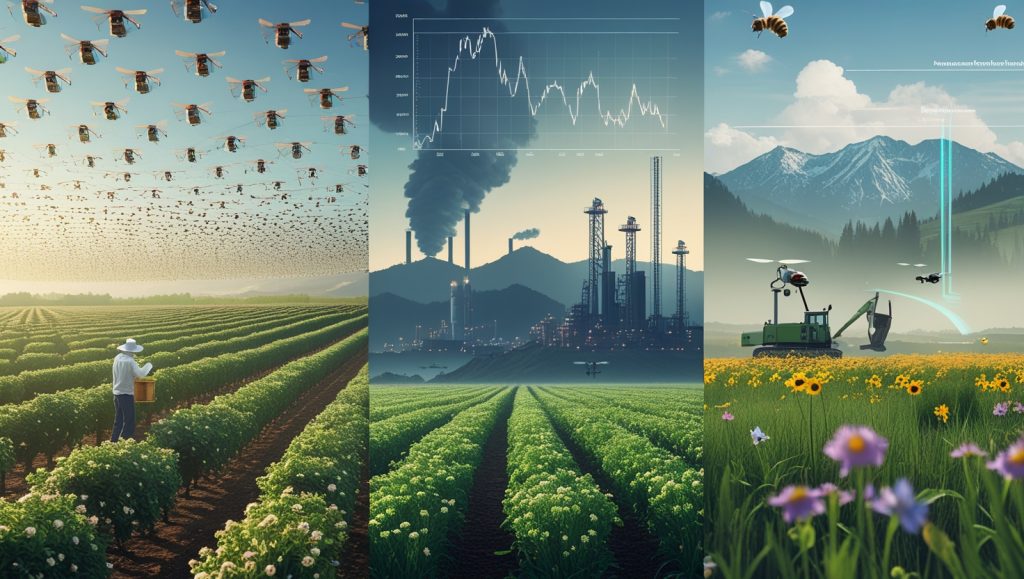
A. The Scaling Paradox
Replacing bees with robots is a numbers game. California’s almond industry alone requires 2.1 million hives annually — roughly 70% of all U.S. honeybees. To match this with drones, farmers would need 2.5 trillion units operating nonstop during bloom season.
“It’s like trying to replace all taxis in New York with self-driving cars overnight,” says agricultural economist Dr. Julian Ramirez-Villegas. “The infrastructure doesn’t exist.” Similar scaling challenges are evident in autonomous mobile robots, highlighting barriers to widespread adoption of robotic pollination solutions.
B. Environmental Trade-Offs
A 2023 study in Nature Sustainability found that producing lithium-ion batteries for pollinating drones generates 43% more CO2 than maintaining natural bee colonies. Moreover, rare-earth mining for drone components devastates ecosystems in Chile and Congo. These trade-offs echo concerns in robotics for climate change solutions, where robotic pollination solutions must balance innovation with sustainability.
C. Biodiversity Blind Spots
Robotic solutions focus on crops, but 87% of wild flowering plants rely on pollinators. “If we save apples but lose wildflowers, entire ecosystems unravel,” warns Dr. Lynn Dicks of Cambridge University. This limitation underscores the need for holistic robotic pollination solutions, as seen in untethered deep-sea robots, which address niche ecological challenges.
4. Ethical Crossroads: Should We Engineer Our Way Out of Crisis?
Critics argue that robotic pollination solutions divert attention from systemic issues. “This is a moral hazard,” says author and farmer Wendell Berry. “We’re using tech to justify continued pesticide use and habitat destruction.”
Yet for farmers like Maria Gonzalez, pragmatism trumps idealism. “I’ve reduced pesticides by 40% and planted hedgerows, but my trees still need pollination. Until policies change globally, robots might be my only option.” This tension mirrors debates in AI ethics, where robotic pollination solutions raise questions about long-term consequences.
5. A Hybrid Future: Where Technology and Ecology Converge

Policy Levers: Learning From the EU’s Success
The EU’s Farm to Fork Strategy — banning bee-harming pesticides and allocating €100 billion for agroecology — offers a blueprint. Since 2020, France has seen a 12% rebound in wild pollinators.
Farmers as Conservationists
Regenerative farms like Gabe Brown’s Ranch in North Dakota blend crop diversity, cover crops, and integrated pest management. Brown’s yields now exceed conventional farms by 30%, proving ecology and productivity can coexist.
Citizen Science: Empowering the Public
Apps like iNaturalist and BeeWatch let users log pollinator sightings, creating real-time maps for conservationists. In 2023, these platforms helped identify 14 new pollinator habitats in urban areas.
FAQ: Your Top Questions Answered
Can robotic pollination solutions fully replace bees?
Not in the foreseeable future. Bees pollinate complex flowers (e.g., figs, vanilla) that robots can’t yet handle. The goal is supplementation, not replacement.
Are these technologies affordable for small farmers?
Currently, no. Drone systems cost $5,000–$10,000 per acre. However, startups like BeeHero offer rental models at $200/acre/month.
Do robotic pollinators harm bees?
Indirectly, yes. Overreliance on tech may reduce incentives to protect natural pollinators. Direct collisions are rare but possible.
A Crossroads for Humanity
The rise of robotic pollination solutions reflects humanity’s ingenuity — and hubris. While these innovations offer hope, they must be paired with aggressive conservation. As Maria Gonzalez now plants clover between her almond trees and rents drones for peak bloom, she embodies this balanced future: one where technology supports nature, rather than supplants it. For more on balancing tech and sustainability, check out why robotics in entertainment will dominate by 2030.
Whats Next?
Join the conversation. Subscribe to our newsletter for updates on sustainable tech.
